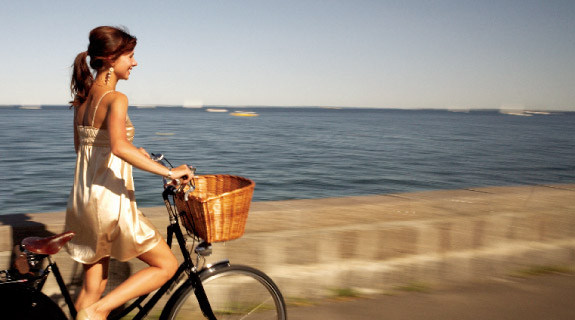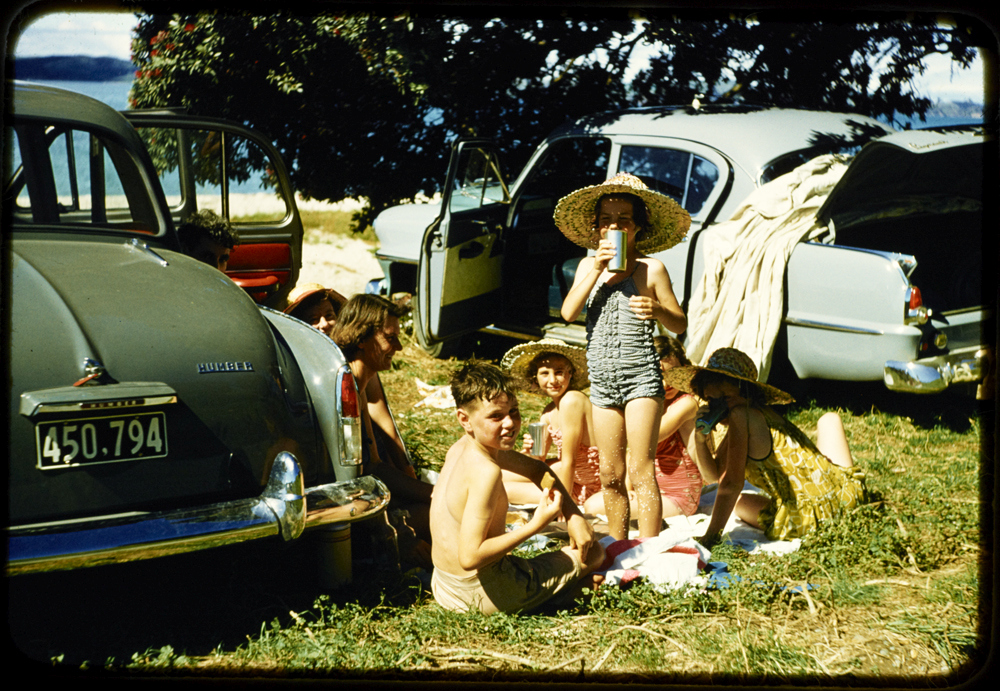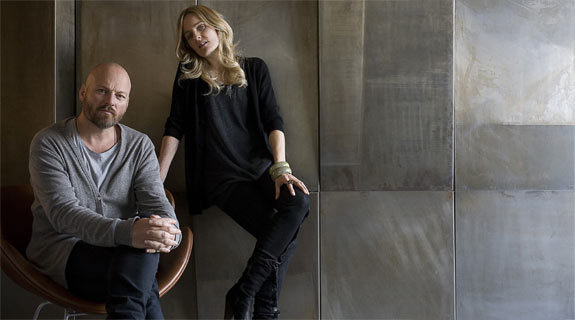Venturing onto the road on two wheels can feel like taking your life in your hands. Andy Kenworthy explains why we should be jumping on our bikes anyway. Plus: Tips for cycling safely—and in style
When Andy Kenworthy moved to New Zealand, he was shocked to discover that getting on his bike was a death-defying experience. Two years later, he’s no longer terrified of Kiwi drivers. He tells us why we shouldn’t be afraid either
PHOTO: Chris Skelton




Whoosh. Another steel blur blitzes by at 100 kilometres per hour, inches from my right elbow. If I’d swerved for a pebble or to cough up an insect, I’d be drifting through bright lights towards my smiling ancestors. Others haven’t been so lucky.
In September a group of cyclists was hit by a car that failed to halt at a stop sign on Tamaki Drive in Auckland. The accident put four of the cyclists in hospital and left one fighting for his life. The unfortunate incident also uncovered a simmering resentment between those who travel on four wheels and those who choose two, unleashing an intense online and on-air slanging match between cyclists and motorists.
In the wake of the accident, the New Zealand Herald asked its readers how cycling could be made safer; more than 700 comments were left in the ‘Your Views’ section of the paper’s website (good.net.nz/2/yourviews). Reading them, you’d be forgiven for assuming that a gang of cyclopaths, over-stimulated by lycra and their own body odour, had dragged the offending motorist from her car and beaten her to death with titanium bike parts and spare tyres. Popular suggestions included requirements for cyclists to be registered, licensed or removed completely from the roads.
“Impeding commerce for the sake of personal recreation is a rather selfish action to add to an already congested roading system,” wrote one. “Cycles are for a bygone era in my opinion, not for modern traffic and narrow roads,” offered another. One particularly incensed respondent called cyclists “lycra-clad homos”, and suggested they should be banned.
Cyclists find these sentiments depressingly familiar. Good columnist, business commentator and keen pedaller Rod Oram is currently training for two charity rides in addition to his normal cycling routine. He’ll cycle 10,000 kilometres this year alone, and has commuted by bike in Vancouver, Toronto, Chicago, New York and London. Nothing prepared him for cycling in New Zealand.
“In all the other places I have ridden, I have never encountered the sheer irrational anger towards cyclists you get in New Zealand, especially in Auckland,” he says. “You can be riding along doing no harm to anyone and have abuse shouted at you. Friends of mine had bottles thrown at them. There’s a constant sense of threat I can’t explain.”
Our roads are so intimidating that many people won’t even get on a bike. A recent University of Otago survey found that driver attitudes are the main thing stopping people from cycling to work, rated twice as important as whether or not cycle lanes were available.
Clearly, there’s no love lost in this country between drivers and cyclists. But does that mean cycling is as dangerous as recent ranting has made out? The numbers suggest otherwise. According to the latest figures from the Ministry of Transport, 366 people were killed on New Zealand’s roads last year—a 13 percent drop on the year before, in line with the generally downward trend in road death rates since 1990.
Drivers make up 45 percent of road fatalities. Thirteen percent of the toll are motorcyclists, eight percent are pedestrians, and only three percent are cyclists. This suggests three things. One, if you really want to kill cyclists, bolt motors to their bikes. Two, some people probably believe walking should be a licensed activity, complete with registration plates. Three, roads are inherently dangerous places—but other road users are getting killed a lot more frequently than cyclists.
Even so, the Ministry of Health recently reported that road death is only the 16th most common cause of carking it in New Zealand. High cholesterol, high blood pressure, being overweight and insufficient physical activity all feature in the top ten, and air pollution is number 12. You can fight all of them by feeling the fear and riding your bike anyway.
The Transport Agency estimates that if New Zealanders cycled just five percent of trips under seven kilometres, instead of driving them, we would save 22 million litres of fuel and cut national carbon emissions by 0.35 percent. And although increasing the number of cyclists on the road could have tragic consequences—the Transport Agency report acknowledges it may lead to five more cycle accident fatalities per year—it could also prevent 116 premature deaths from ill health, including five or six triggered by poor air quality.
Perhaps it’s not cyclists who should be afraid, but our tourism industry. With tourism making up around 18 percent of our export income, this nasty battle over bikes could have very tangible effects on our economy. “In a way this goes well beyond cycling,” says Rod. “It makes New Zealand look like a really brutal place. Cyclists are going to say, ‘Let’s go to New Zealand’, then read about some of the things happening on our roads and say, ‘What about Canada?'”
Research from the Ministry of Tourism suggests that if cycle tourism is developed correctly in New Zealand, tourist spending in that area could double to $640 million. To help make this happen, the government has allocated $50 million over three years to the New Zealand Cycleway Project. Work on seven new trails up and down the country will begin any day now (see www.tourism.govt.nz for updates).
Meanwhile, the Get Across campaign (www.getacross.org.nz) is still pushing hard for cycling lanes across the Auckland Harbour Bridge.
More than manners
None of this answers the big question: why do so many Kiwi motorists want to drive cyclists off the road? Perhaps it’s because so few of New Zealand’s 1.3 million cyclists use their bicycles regularly for transport. Commuter cycling has collapsed since the 1980s; less than two percent of our workforce currently bikes to work. Cycling now makes up about one percent of all trips in this country, compared with 3.6 percent 20 years ago.
Our use of bicycles for recreation may be contributing to the perception that bicycles are frivolous toys that don’t need to be on the road. “Cycling’s seen as a sport, rather than as transport,” says Glenn Shaw, marketing manager of Nextbike, the company behind the public rental bikes beginning to appear around the country (www.nextbike.co.nz). With its upright, European-style ‘cruiser’ bikes, Nextbike hopes its cycles will be seen as just another way of getting from A to B.
“Cycling can be a very showy sport—guys out with all the latest labels—but you don’t need your cleats and your racing bike and your flash pedals. When you were a kid you just jumped on in whatever you were wearing,” says Glenn. “Cycling should be really normal. You don’t need a lycra racing top—just get on a bike and ride it to the shops, or ride it to work.”
On the other hand, dressing up as a luminous lycra-clad Christmas tree festooned with all the flashing lights you can afford is not without benefits, particularly when riding rurally. (The most common way to be killed on a bicycle is to have a vehicle slam into you from behind on a rural open road.)
“Motorists aren’t used to seeing bikes on the road as part of normal traffic,” says Glenn. Generations of Kiwi drivers are more accustomed to seeing cattle in their way than bicycles—but when was the last time you heard someone threatening to ram the local dairy herd for not indicating? Still, it’s a good idea to act like a human while cycling. Making eye contact and smiling, for example, is one of the best ways to get drivers to treat you with due care and attention.
Safety and visibility go hand in hand, which is why some cyclists choose to ride in large groups: it’s a reliable way to slow cars down. “Safety in numbers” is one of the main tenets of Critical Mass, group rides held on the last Friday of every month in more than 300 cities around the world, including Auckland. Similarly, the Frocks on Bikes group (www.frocksonbikes.wordpress.com) rides to highlight various environmental issues, but mostly their right to be on the road. Interestingly, this mostly female group has found that cycling in their finest frocks seems to trigger more respect from drivers.
The more public and formal face of promoting cycling in these isles is the Cycling Advocates Network (CAN). CAN lobbies government and helps local groups lobby councils to increase facilities and protection for cyclists. “Ninety-nine percent of drivers share the road safely,” says spokesman Stephen McKernon. “It’s that one percent you’ll have a problem with, but you really notice it on a bicycle because you are so vulnerable.” He cites a lack of resources: “There are about two million car drivers in this country and about half of them are cyclists. This is not a minority. But cycling gets about four percent of the transport budget.”
Another problem is attitude, he says. “Internationally, New Zealanders are notoriously aggressive on the road, and a lot of cyclists have that mentality too. Some act irresponsibly and cause problems for themselves. Most adult cyclists drive as well, but a lot of people act like anything that slows them down shouldn’t be on the road.”
Despite the bad-ass cyclists we’ve all seen running the occasional red light, cyclists have primary responsibility in only 27 percent of all cyclist-vehicle crashes in which they are injured or killed, according to the Ministry of Transport.
Rule changes are frequently touted as one way to improve safety for cyclists, but the current rules would do the job—if everyone actually abided by them. The road code suggests a minimum passing distance around cyclists of 1.5 metres, providing everyone with a vital safety margin. The RideStrong online community (www.ridestrong.org.nz) is campaigning to make this rule legally enforceable; sign the petition at www.ipetitions.com/petition/ridestrong.
Do we all just need to be more polite on the roads? It wouldn’t hurt—but whether we look out for other people’s safety in a potentially life-or-death situation is not a matter of courtesy. It is not simply rude to pass within inches of a cyclist while driving at 60 kilometres per hour, it’s as reckless as threatening them with a loaded gun.
Rather than brushing up on our manners, perhaps we should all just slow down. Cyclists don’t need to jump red lights and blitz through the traffic. And if you’re in your car, sitting on a warm comfy seat listening to some music, maybe supping on a coffee, is it so inconvenient to slow down a little for your fellow human beings?
As we begin to respond to the threats of climate change and peak oil, bicycles are likely to become an increasingly important part of our transport system. The switch to cycles has already begun: in 2005 the import of bicycles to New Zealand outpaced new car registrations. They’ve continued to do so ever since. About 50,000 more bikes than new cars hit our roads each year.
Overseas, as GM recently learned in the bankruptcy court, it’s the petrol-driven car whose days seem numbered. And the more cyclists that take to our roads, the more they must be respected and catered for—and the safer it’ll be for us all.
Want More?
How to avoid ten common collisions:
good.net.nz/2/bikesafe
The Road Code on driving near cyclists:
good.net.nz/2/roadcode
The Road Code for cyclists:
www.ltsa.govt.nz/factsheets/01.html
Cycling to work tips:
www.ltsa.govt.nz/factsheets/01.html
www.can.org.nz/node/4446
The myth of the scofflaw cyclist:
good.net.nz/2/scofflaw
Copenhagen Cycle Chic manifesto:
good.net.nz/2/cyclechic
The cyclist’s code
Show respect
Sharing the road is a two-way deal. Give other users a fair go. Follow the rules of the road. Don’t run red lights. Only ride two abreast when it is safe and considerate to do so. If you’re riding in a bunch, ensure the bunch isn’t so big that motorists can’t pass safely. If on a long, narrow, windy road where it is difficult for motorists to pass safety, pull over and stop to let them through.
Communicate
Use hand signals to tell other road users what you intend to do. Signal well in advance as a matter of law, courtesy and self-protection.
Be predictable
Ride in a consistent and predictable manner. Avoid sudden movements such as swerving around obstacles, in and out of the flow of traffic or changes in direction that may take motorists by surprise. Give yourself a clear riding line where you can be seen by other road users.
Scan for hazards
Be aware of your surroundings and of what other road users are doing around you: behind, at your side and in front, people getting out of parked cars, pedestrians and dogs. Also look out for hazards on the road surface that may cause you to lose control: loose gravel, glass, metal service covers, painted markings (especially when wet), storm water grates and road edgings.
Expect the unexpected
Ride defensively and anticipate hazards, particularly the actions of other road users who may not have seen you. Intersections, roadside access ways and driveways, people opening car doors are all high-risk areas for cyclists. Don’t expect to be granted the right of way in any instance, regardless of the law!
Take your space
If you’re on a narrow road or lane, passing parked cars, negotiating an intersection or roundabout, or travelling at the same speed as other traffic, you are likely to be safer taking your space in the traffic like a car. This will increase your visibility while making it clear to other road users that you need space and it is not safe for them to pass you at this moment. Before taking a space in traffic, check to ensure you have room to do so and it is safe. Signal in advance so other road users are clear of your intention.
Seeing eye-to-eye
Make eye contact with drivers, particularly at intersections, to make certain that you have been seen, and that if you are signalling to turn your intentions have been understood.
Reward good driving
Give motorists a courteous wave for showing you respect!
Take the road less travelled
If you can, use routes with less traffic, lower speeds or cycle lanes. Don’t think like a motorist when choosing your route.
Leave racing for race day
Speed on a bike is exhilarating and thrilling, but there is a time and place. Racing through traffic, particularly at intersections or if passing on the left of stationary or slow-moving traffic will only get you to hospital faster.
Be seen
Make your presence known. Wear bright clothing. At night, in poor light or inclement weather, use reflective gear and lights in the front, side and rear that make you visible from all directions. Flashing lights are a must. Ensure the batteries are strong and your lights are bright!
Use your head
Don’t just wear your helmet—make sure it is properly fitted and fastened. The helmet should fit snugly and not move when you shake your head.
Be prepared
Look after yourself, your gear and your buddies. Ride within your abilities and equip yourself adequately for the ride and the conditions. Keep yourself fuelled and alert, and ensure your bike is in good working order. Plan for when things go pear-shaped, with tools, first aid and phone, particularly if you are heading into the back of beyond.







